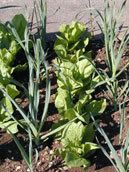
Lettuce, tomato, cucumber,bell pepper, and green onions... sounds like the start of a great salad right?? Throw in a few shrimp or cut up chicken breast and I'm a happy girl. Now I can't grow shrimp in my garden and a few chickens might make my harvest a little more difficult but I can produce the rest of my ingredients in a great abundance as long as I know what grows well next to each other.
A great garden does not consist of only 3 or 4 plants. Many veggies and herbs have little buggy friends that help them to stay healthy by inviting new friends and consuming their enemies. You can help your harvest greatly by simply planting certain varieties near one another and on top of one another for that matter. This is called Interplanting your crops. There are many different ways you can do this and I'll list a few below. Not only will this save space if you have a small garden but it will also save on time when you harvest and it looks great to see such a full lush garden. Choosing the right varieties for interplanting will keep your weeds to a minimum and help you to save space for next seasons crops.
There are many ways to Interplanting (or Intercropping)
- Row Intercropping - growing two or more crops at the same time with at least one crop planted in rows.
- Strip Intercropping - growing two or more crops together in strips wide enough to permit separate crop production using machines but close enough for the crops to interact.
- Relay Intercropping - planting a second crop into a standing crop at a time when the standing crop is at its reproductive stage but before harvesting.
- Mixed Intercropping - growing two or more crops together in no distinct row arrangement.
This is a beautiful way to incorporate lots of different plants together. The flowers and herbs with attract more pollinators to your veggies that they would not be able to do alone.
Here are a few examples that you could try this year....
- Corn, Beans, and Squash
- Marigolds or Basil and Tomatoes
- Broccoli and Dill
- Onions and Bush beans between Strawberries
- Radishes and Carrots
- Leeks and Sweet Potatoes
What plants do you find work well together? Have you ever tried Interplanting? I'd love to help you have a great harvest this Spring and Summer. If you have any questions please leave me a comment. Have a wonderful day. It's beautiful here!! I'll try to be outside as much as possible.




3 comments:
So I guess I should have planted my herbs in my garden instead of in containers this year? :-)
Last year my basil was huge. I could barely keep up with it, so I finally let it go after I harvested enough to dry. It made beautiful flowers that attracted quite a few bees.-lol
I also didn't realize how much oregano spread on the ground. Herbs love me it seems. My rosemary never dies. I have enough to share with my whole neighborhood. :-) So this year I decided to put them in containers. Just to keep up with them better. Maybe i'll just put them up against my garden boxes.
I admit it, I do not know much about plant compatability. My grandparents tried to teach me as I was growing up, but of course I didn't listen.
Pulling them closer will definitely help you!! Don't you love when they can take care of themselves and don't need babying lol
Even if one of your boxes are filled with your herbs you'll be fine. You can always use the basil and other taller herbs or flowers to help shade shorter, more light sensitive plants like certain cultivars of lettuce and other leafy greens.
I'll be doing a "Don't plant these together post soon"... Hopefully it won't be too late for anyone lol
Thanks for stopping by!!
Hey Daisy,
I m going to till the garden this weekend but is there a website that tells you which one to plant with which???
Post a Comment